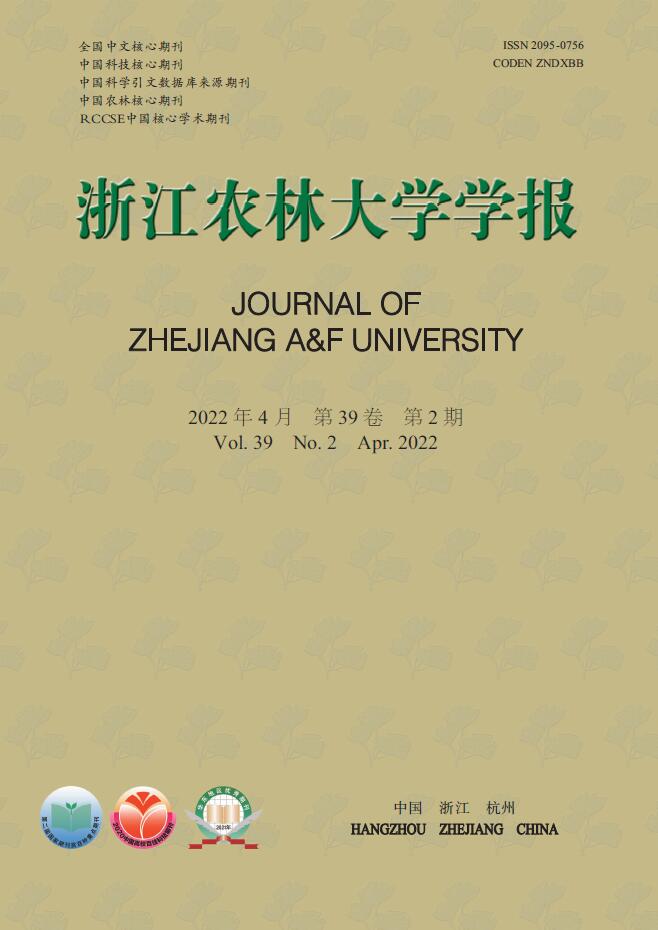-
基质栽培是指用特制的育苗基质将植物根系或种子固定进行育苗生产的一种无土栽培技术,发展到今天,栽培基质的工业化生产已经经历了配合基质、标准基质和定制基质阶段,并在21世纪初,在定制基质基础上,通过添加特定成分达到抗病、防虫、抗旱、抗分解等特殊性的目的要求,即功能基质阶段[1-2]。栽培基质的应用向着多元化方向发展,在基质材料的选择上,同样发生着变化。泥炭是公认的理想栽培基质,但它属于不可再生资源,大量开采会对环境造成不可逆的破坏,农林废弃物作为农林生产中产生的残留物[3-4],具有来源广泛、养分丰富的特点,利用这些物质作为基质原材料,可以解决大量的废弃物污染问题,其中丰富的养分可以保障植物的正常生长,减少化肥的使用。将农林废弃物配合黏结剂、保水剂、抗冷剂[5]等添加剂进行成型有机栽培基质的生产,可以实现优势互补,改善基质使用效果,为农林废弃物资源化利用和生态环境修复提供新的可能。本研究综述了高持水性成型有机栽培基质的发展和应用现状、基质的水分调制以及对土壤的改良情况,在此基础上提出其存在的问题及未来的发展方向,以期为今后栽培基质的发展提供借鉴。
-
传统的无土栽培主要依靠营养液为植物提供营养,成本高且操作困难。而有机生态型无土栽培,可大大简化基质栽培施肥技术[6]。它是以有机废弃物经发酵处理,配以少量泥炭、蛭石、珍珠岩等矿物介质制成的,能满足作物正常生产、无毒、可再生利用的栽培介质[7]。通过合理的原料配比,有机基质可以达到全营养供应,栽培时直接用清水灌溉,作物易成活,普通生产者也可操作掌握,是基质向着多样化、无害化、简单化方向发展的重大成果。
-
利用压缩成型机将筛选好的有机基质进行压缩成型,可生产出利于存放、运输、持水性优良、营养丰富且持久释放的新型栽培基质块[8]。相比于传统育苗,基质块可以脱离塑料穴盘等栽培容器,无需自行准备苗床土、添加肥料、消毒、装钵等环节,操作更加方便,提高了育苗效率[9]。基质块可以随苗木一起移栽到土壤中,在减少苗木根系损伤的同时,有机肥起到了改善土壤肥力状况的积极作用。
-
在基质块的压缩过程中,物料种类及含量、黏结剂、含水量、成型压力等直接影响成型基质产品的质量和性能,针对不同的生产需求,从多方面分析研究,确定最佳生产工艺,在减少压缩能耗的同时,提高成型产品的质量。
-
现阶段可供利用开发的有机生物质资源包括农作物秸秆、树木枝丫、畜禽粪便、能源植物、工业有机废水、城市生活污水等[10]。各生物质的组成成分不同,基质中各组分含量也存在差异,在没有黏结剂时,生物质的挤压成型主要依靠木质素,原料中木质素的含量直接影响成型基质块的物理性状和压缩过程中的能耗多少[11-12]。
-
黏结剂是将物料黏结成型的辅料,黏结剂可以明显提高基质钵的黏结强度,增加颗粒的聚合度,对成型过程中的压力有一定的补偿作用[13]。针对不同的生物质原料采用适合的黏结剂,可以起到事半功倍的效果。使用蒙脱石、高岭石和磷酸盐混合制作的压缩基质钵专用固化剂(专利号CN98119022.7),具有良好的实践效果;孙恩惠等[14]以稻壳为原料,添加大豆蛋白基黏合剂可以增强基质成型性能。孙勇等[15]研究发现:碱处理玉米秸秆浆液可以提高制钵浆液的黏度。
-
原料含水量过高或过低都会增加基质压缩成型过程中的能耗比,影响压缩成型效果,必须严格控制。姬爱民等[16]指出含水量过高会导致成型块不实或者成型较困难,同时自然放干后成型块易碎。纪敏等[17]研究得出:合适的基质湿度在基质标准化生产中可以提高成型产品的合格率和合格苗率。在控制其他因素不变的情况下,随着含水量(适宜的范围)的增加,压缩过程中的能耗比减少[18-19]。
-
压力是基质压缩成型的基本条件,在一定范围内,压力大小跟成型后基质的密度呈线性正相关关系[20-21]。压力过低,基质不能成型或成型后松散易碎;压力过高,基质的孔隙度降低,不利于根系生长,且能耗增加,适当地加大压力可以提高基质的持水能力。蒋希雁等[22]研究表明:在控制其他因素不变的情况下,压实度从70%提高到95%时,高羊茅Festuca elata的平均根长从17.2 cm减小到12.9 cm,但是根系对基质吸力的影响加大,植被土的持水能力提高。
-
温度通过影响物料的塑性和流动性,加速物料粒子的黏合和成型[13]。加热温度75~100 ℃可软化物料中的木质素,增强黏结性,压缩效果好[23]。但温度不应过高,否则会影响到基质的容重和保水率[21],同时也会增加压缩过程中的能耗,减少设备的使用寿命。
-
根据颗粒填充和变形机制[24],在物料成型时,大颗粒主要依靠颗粒间的交错黏结,小颗粒主要依靠分子间的范德华力、静电力黏结,所以物料的颗粒粒径分配显著影响基质成型效果。粒径小,分子间的吸引力增强,黏结力增大,易于成型[25];粒径太大,成型效果差,且易增加机器的能耗和磨损。但粒径过小,摩擦系数会较快减少,增加粉碎电耗和成本[26]。
颗粒的粒径大小和排列方式还影响基质的孔径分配,田吉林等[27]通过不同颗粒粒径配比实验表明:颗粒配比明显影响基质的物理性质、水分常数和栽培作物的长势。
-
不同的尺寸和形状会影响成型基质产品的密度和成型过程的能耗。在较大压力的情况下,减小模具半径有利于增大压缩密度[28]。胡建军[12]以小麦 Triticum aestivum秸秆为原料进行秸秆冷态压缩成型发现:在物料含水量、压缩速度一定时,模具长径比为5∶2,开口锥度为45°,物料压缩密度达到最大,而且能耗比适中。
-
淡水资源短缺是制约农林业生产和发展的重要因素之一,添加化学保水剂一直是提高土壤保水性的研究热点。日本研究开发了聚丙烯酸盐高吸水树脂[29-30];美国、法国、韩国也研制利用高分子材料保水剂进行干旱地区的土壤改良[31];目前市场上常见的保水剂有丙烯酰胺-丙烯酸盐共聚交联物、淀粉接枝丙烯酸盐共聚交联物[32-33]。添加化学保水剂明显提高了土壤的持水能力[34],这些合成的化学物质虽然本身无害,但除了淀粉会自动分解,其余化学物质长期存在于土壤中,会造成环境的负担,易造成二次污染[35-36]。
自然界存在着天然安全的保水材料,如木质素、腐殖酸、生物质炭[37]、纤维素[38]等。刘钊钊等[39]研究发现:添加木质素可改善黄土持水性;田露等[40]将腐殖酸和膨润土旋耕在内蒙古黄土高原的干旱土地上起到很好的保水、增产效果。但这些材料成本高,难以大范围使用。农林废弃物经高温堆肥后,保留有大量的腐熟有机质,可以作为很好的栽培基质[41-42],可大幅节约成本,实现废物利用,在田间快速降解[43],对环境友好,有较高的实用价值。将农林废弃物与保水材料配合使用,可以改善农林废弃物作为基质原料在结构、水稳性等方面的弊端[44-45],增强其保水保肥能力[46];将其压缩制成高持水性成型有机栽培基质,可以减少塑料托盘的使用[47],简化基质育苗过程。
高持水性成型有机栽培基质能利用降水充分吸收水分、缓释水分,减少绿化时客水使用,为苗木营造更长的生长旺季,在“以水定林”的政策下,提高困难立地绿化的增量。利用高持水性基质育苗,整体移栽到困难立地,苗木生长环境变化小,无缓苗期,基质内水分养分充足,可有效提高其成活率。
-
肖海华等[46]将不同种类、不同粒径的保水剂添加到以草炭为主要材料的栽培基质中,发现不同保水剂种类对基质保水性、栽培植物干质量、植物水分利用效率影响不同,但均起到较好的改善作用,通过不同粒径的保水剂添加试验结果发现:粗粒的保水剂比细粒的效果要好。卫星等[4]将不同比例的保水剂添加到农林废弃物基质中研究其持水效果,结果表明保水剂与基质体积比为1%时,混合基质的保水性效果较好,添加保水剂后的农林废弃物混合基质在保水性方面显著优于以草炭为主要组成的基质。杨龙元[48]以牛粪腐熟料和牛粪蚯蚓腐熟料为主料压缩制成成型基质块,证明两者本身具有较好的机械强度和抗破损能力,通过添加稻草丝、高吸水树脂,可以明显改善成型基质块的通气性、吸水持水特性、运输及稳定性等各方面的功能,有利于种子萌发和幼苗生长。刘方春等[49]研究表明:在育苗容器中添加保水剂与无机肥料可以促进白蜡Fraxinus chinensis中后期生长,增加白蜡对干物质、养分的积累速率和积累量。
利用有机物质作为原料制作保水剂,已取得良好效果。如程红胜等[50]利用自制的生物质炭基保水剂与传统的聚丙烯酰胺保水剂进行对比试验,发现前者可以有效提高土壤的饱和含水率,增加土壤水分含量,相比于传统化学保水剂,可以进一步增强土壤的保水能力,在高施用量时,生物质炭基保水剂可以提高水分利用效率,节约用水。戎泽[51]将3种椰糠基保水剂以不同用量施入土壤中研究其持水性能,结果表明:椰糠基保水剂具有较好的重复吸水性,3种保水剂均能减少土壤容重,提高同一吸力下土壤含水量和饱和含水量,增加土壤进气值,对土壤的有效水含量、抗旱性也有不同程度的改善和提高。秦玲等[52]在砂土中加入腐质化程度低的高位草炭,可以明显改善混合基质的孔隙度、田间持水量、饱和含水率,基质中草炭含量越多,在干旱条件下基质体积的收缩程度越高。姚璐等[53]利用膨润土-菌渣复合材料进行盆栽试验,证明了其良好的保水保肥性能,当复合材料中膨润土含量增加时,吸水性能增大,在充分吸水后,复合材料可以长时间保持较高的水分含量,同时复合材料具有良好的保氮、保钾能力,在盆栽试验中,复合材料可以促进白菜Brassica pekinensis种子萌发,提高其在干旱条件下的存活时间。一种环保型生物活性营养钵(专利号CN01126888.3)使用植物纤维粉(稻壳粉、稻杆粉等),天然有机质(泥炭土、水苔等),生物活性营养剂(海藻素),无毒黏合剂等配料,通过热压成型的方式制成,可以实现育苗钵和植株的整体移栽,缩短缓苗期,改善土壤持水能力,提高苗木成活率。
由此可见,通过将农林废弃物与吸水性强的无机材料、生物质保水材料等混合使用,可以提高基质的持水能力,促进苗木生长。但是,保水性基质难以推广使用的主要原因是成本问题,需要进一步对原料和产品加工等进行探索。
-
高持水性基质可以快速吸收水分,并保存起来,减少水分流失,但是基质的主要功能是为植物体提供稳定协调的水、肥、气、热以满足其生长需求[8]。植物根系吸收水分难易主要与基质溶液渗透压和基质颗粒对水的吸附力有关,而与基质含水量无关,基质对水的吸持能力越大,植物可利用的有效水分含量越少。高持水性基质在保证自身高吸水性的情况下,也要满足对植物根部充足的氧气供给和水分的有效性。
基质水气调控就是在掌握基质水气调控原理的情况下,调节基质的物理结构以满足植物正常生长需求。将泥炭按不同粒径比例混合组配,可以满足植物水气需求,构建良好的通气透水条件[1]。吴剑锋[54]研究认为:基质原料的颗粒粒径大小直接影响基质水分的有效性和空气的体积大小,通过将原料按不同粒径合理组合搭配,可以达到理想的水气构型。王忠强等[55]认为:选择适宜吸水性和通气性的基质原料可以满足植物生长需要的物理性状,目前除了低分解藓类泥炭满足条件外,不同功能的原料混合起来也可以实现。
-
有机基质分解后进入土壤,可以增加土壤有机质,改善土壤理化性质[56-57],提高土壤储水能力[58]。在一定范围内,土壤有机质含量越高,土壤的含水量越大,同时可以减少土壤的水分扩散率,提高土壤的保水能力[59]。高飞等[60]研究表明:有机肥进入土壤能提高供试土壤的保水能力,促进土壤结构的优化,进而提高作物的产量。李艳霞等[61]将城市污泥堆肥用作草坪基质,显著增强了黑麦草Lolium perenne对氮的吸收,提高了土壤的速效氮和速效磷含量。袁东海等[62]在人工湿地基质净化磷素污染时,利用粉煤灰或矿渣添加到砂子和土壤基质中,可以增强基质的磷素吸收,大大增强其净化效果。还有研究表明[63-64]:在连作营养基质中添加生物质炭对细菌的群落结构多样性以及酶活性有明显的调节作用。秸秆覆盖对土壤理化性质具有积极的影响,明显改善了土壤保水保肥性能,提高土壤中速效养分含量[65],而将秸秆与无机肥料混施,有助于提高土壤有机质活性和改善土壤肥力状况[66]。用高持水性成型有机栽培基质进行育苗栽培,基质随苗木移栽后对土壤的改良作用有待进一步研究。
-
基质育苗操作复杂,应用性差。用农林废弃物进行有机栽培基质的合成在中国已取得重大进步,但基质的配方复杂多样,不同的基质需要不同的添加剂和速效养分的加入以改善其理化性质和养分状况,在实际生产和操作中往往因为这些辅料的种类和数量达不到要求而造成作物减产。
基质的标准化生产发展缓慢。由于农林废弃物来源不一、种类多样,给有机基质的标准化生产带来阻碍,目前尚未形成规范的基质生产流程,基质难以大规模生产利用。另一方面,对于成型基质产品缺乏系统的检验标准,基质产品质量差异明显,利用效率低下。
基质对特殊环境的适应性差。干旱、沙化、盐碱等造林困难的地块,在陆地面积中占巨大比例。栽培基质在苗圃、温室等特定环境空间内的应用已趋于成熟,在气候条件恶劣、栽培环境差的困难立地中应用研究较少。
缺乏基质移栽到土壤后的跟进测试。有机基质中含有丰富的有机物质,对植物生长和土壤理化性质的调节有积极的促进作用。现在的基质栽培实验大多停留在植物生长状况的研究,缺乏苗木移栽后对土壤及周围环境的影响的研究。
-
加强基质生产的标准化、规模化建设。实现基质生产从研究室到工厂化的转变,基质生产标准体系的建设与完善是前提和基础。对于该过程中有机基质种类复杂的问题,可以按照产品的不同用途划分基质类型,制定相应的生产和质量控制标准,生产不同档次、不同用途的育苗基质,同时要加强基质制作工艺的完善,提高基质产品的质量稳定性,降低成本。
新材料的研发和使用。在提高基质持水性上,保水剂、表面活性剂[67]的使用取得了良好的效果,但现有基质添加剂多以化学材料为主,功能单一且易对环境造成不可逆的危害,生产高效、多功能、环境友好的新型材料,如微生物肥料[68]、新型包衣材料[69]、微生物保水剂[70]等,并将其应用到基质的生产开发中,对实现基质的品质化生产和可持续发展有重要作用。
专用型栽培基质的研究。在基质生产中,要以实际需求为导向,根据实际环境条件和栽培作物的不同研发对应的专用型基质[71],实现基质生产的多样化需求。
将基质的生产、育苗、移栽研究同时进行。目前人们对于高持水性基质的研究主要集中在原料和配方的筛选上,对基质中的水分运动、养分转换、微生物群落结构变化、基质与植物间的养分输送过程、基质结构的稳定性、配套的肥料施用技术[72]等缺乏系统的研究。基质的研发应与实际生产相结合,在了解其理化性质及与作物相互关系的基础上,实现基质操作的简单化、智能化,从而提高基质的使用效率。
Research progress of high-water-holding molding organic cultivation substrate
doi: 10.11833/j.issn.2095-0756.20210313
- Received Date: 2021-04-23
- Accepted Date: 2021-12-21
- Rev Recd Date: 2021-11-30
- Available Online: 2022-03-25
- Publish Date: 2022-03-25
-
Key words:
- agro-forestry wastes /
- organic substrate /
- trends of development /
- review
Abstract: As a main way of soilless culture, substrate culture is widely used in seedling cultivation and production and recent years have witnessed an increasing interest in the research on the production of organic cultivation substrates using agro-forestry wastes. Therefore, the development of high-water-holding molding organic substrates by adding auxiliary materials such as binders and super absorbent polymers is of great significance to the better utilization of agro-forestry wastes as substrate and soil improvement agent. This study, with an analysis of the the development trend of organic substrate and problems existing in its practical application, is aimed to investigate the current situation of water modulation, high-water-holding molding organic substrates and the soil improvement as well as the existing problems and future development trends in order to provide insight for the development of cultivation matrix in the future. [Ch, 72 ref.]
| Citation: | WANG Yifan, ZOU Rongsong, SUN Xiangyang, et al. Research progress of high-water-holding molding organic cultivation substrate[J]. Journal of Zhejiang A&F University, 2022, 39(2): 446-455. DOI: 10.11833/j.issn.2095-0756.20210313 |









 DownLoad:
DownLoad: